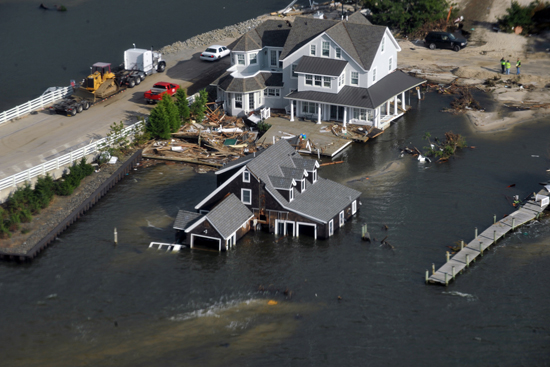Lessons from Hurricane Sandy
Alum catastrophe expert: “We’re ignoring the elephant in the room”

A house on the Jersey Shore submerged in water in the aftermath of Hurricane Sandy. Photo by Jim Greenhill
Once upon a time, insurance companies estimated the likelihood that the properties they insured would be wiped out by a hurricane by looking backwards, and extrapolating from the frequency and amounts of claims for such disasters in the past. That changed in the late 1980s, after Karen Clark (GRS’82, GSM’82) had the novel idea of adding scientific data to the computations.
In 1985, the business and economics major published a paper arguing that the insurance industry was headed for a perfect storm. On the one hand, she wrote, insurance companies had no idea how much they could lose from a single huge storm, largely because the 1970s and 1980s had seen fewer storms than previous decades. On the other hand, the wealth and mobility of Americans had allowed them to relocate in dangerously high numbers to scenic shoreline developments.
“That’s a risk that still grows every year,” the president and CEO of Karen Clark & Company told Bostonia magazine two years ago. “We love to live on the coast. We love to live in beautiful California along fault lines. We are building our highest valued properties in our most vulnerable areas.”
Clark launched her first company, Applied Insurance Research, or A.I.R., in 1987, and built computer models of projected risk based on the expertise of the kind of people insurance companies were not in the habit of hiring: scientists and engineers. Those models failed profoundly to impress most insurance companies, but Clark’s credibility grew steadily through the 1990s. Reinsurance companies, as well as rating agencies like Standard & Poor’s and Moody’s, eventually required insurance companies to use catastrophe models to compute their potential losses. “By 2000,” she says, “it was institutionalized.”
In 2007, Clark was given the Review Worldwide Reinsurance Awards Lifetime Achievement Award, recognizing an individual who has made the most outstanding long-term contribution to the reinsurance industry.
BU Today talked with Clark about the costs and implications of Hurricane Sandy, whose extraordinarily broad path of nearly 1,000 miles resulted in losses of $49.9 billion, according to the economic research firm Moody’s Analytics.
BU Today: Was the damage from Hurricane Sandy unprecedented?
Clark: Sandy was unusual from a meteorological perspective. As Hurricane Sandy moved northward, it interacted with a low-pressure system from the Arctic that actually fueled the storm’s intensity. This low-pressure system not only prevented Sandy from weakening, it also enhanced the size of the storm. A third weather factor, a high pressure system, caused Sandy to veer westward into New Jersey rather than tracking parallel to the coast as is typical for Northeast hurricanes. The simultaneous occurrence of these factors is extreme, with a very low probability.
While Sandy was unusual from a meteorological standpoint, its impacts are not unexpected or unprecedented. The 1938 Great New England Hurricane, also known as the Long Island Express, would cause losses three times higher than Sandy if it occurred today—for both insured and total economic losses. That storm killed 700 people and wiped out most of the towns along the coasts of Long Island, Connecticut, Rhode Island, and southern Massachusetts. Even a repeat of hurricanes Carol (1954) or Donna (1960) would cause insured losses comparable to, or larger than, Sandy.
By focusing on the meteorology, we give the false impression that we haven’t seen anything like Sandy before and we’re not going to see this type of destruction again—both very wrong and dangerous assumptions.
Do recent hurricanes prove that global warming is occurring?
Despite what is sometimes stated in the popular press, no hurricane can be attributed scientifically to global warming. It is not only wrong to attribute recent storms to climate change, it is counterproductive, because it allows us to ignore the real issues and actions that could prevent future suffering and loss.
By attributing every major loss to global warming, we’re ignoring the elephant in the room—the amount of property value accumulating in coastal communities that is vulnerable to natural hazards.
By our estimates, there is nearly $17 trillion of property exposure in coastal counties along the Gulf and East coasts today. New York tops the list, with $5 trillion of property value in coastal counties, followed by Florida, with over $3 trillion, and New Jersey, with $1.5 trillion. With this amount of property value so close to the water’s edge, even minor storms are now causing billion-dollar losses.
Why is it dangerous to blame hurricanes on climate change?
Attributing everything to climate change allows us and our leadership to ignore the difficult questions, such as:
Should there be restrictions on how much and what kind of structures can be built along coastlines and in flood zones?
Should there be stronger building codes for properties built in vulnerable areas so they can withstand at least the effects of minor to moderate storms?
Are we going to invest in communities that are resilient to natural hazards?
If we don’t answer these questions in the affirmative and we simply continue the cycle of devastation and rebuilding, the costs to society will continue to increase with or without changes in climate.
Do you see a worsening of catastrophic weather events? If so, is it recognized by the insurance industry and what is the industry doing about it?
The losses from catastrophic events continue to rise, primarily because the number, size, and value of properties in harm’s way continue to increase. Even without any climate effects, there’s been a doubling of loss potential every decade due solely to demographic factors. So the dramatic increases in losses we’ve been seeing so far are man-made and not due to Mother Nature.
Insurance companies try to factor in the costs of construction and the amount of exposure they’re adding when underwriting different types of policies. These companies use models and other tools to understand and assess catastrophe risk and to be prepared when events do occur.
What are the best estimates of the costs of insured losses, and of the total loss, from Sandy?
There is a wide range of loss estimates for Sandy. Insured loss estimates range from $7 billion to $20 billion and total economic loss estimates run as high as $50 billion. I think the economic losses may be even higher than $50 billion, and our insured loss estimate for Sandy is $12 billion.
It’s difficult to estimate the losses so soon after a storm, particularly one like Sandy that caused so much flooding and damage to infrastructure. Most of the total loss will not be covered by insurance, because for the most part, private insurance covers wind damage, but not storm surge or flooding losses.
Is there general agreement among insurers on the costs of Sandy?
While there’s no one number that all companies have agreed upon, there is general agreement the wind damage will be extensive—not so much because of the storm’s intensity, but because of its sheer size. Damaging winds extended hundreds of miles to either side of the storm track even though Sandy was transitioning from a Category 1 hurricane to a post–tropical storm at the time of landfall.
Insurance companies are now busy trying to settle hundreds of thousands of claims, and that’s their top priority. Companies are not too worried about the final tally because a storm of this size can be handled by the industry.
Will Sandy change the way catastrophic insurance is sold?
Sandy is not likely to have a significant impact on the private insurance market, because a loss of this size is well within the expectations of insurance companies. Sandy is not likely to cause any company insolvencies or disruption to the insurance market. The insured loss is likely to be much less than the loss from Katrina, for example. On the other hand, Sandy may have an impact on the National Flood Insurance Program (NFIP) and how the federal government sells flood insurance. For example, the Federal Emergency Management Agency may tighten standards for disaster payments for states and bar the NFIP from insuring areas subject to frequent large storms. Flood premiums may rise after Sandy to better reflect the true risk.

Comments & Discussion
Boston University moderates comments to facilitate an informed, substantive, civil conversation. Abusive, profane, self-promotional, misleading, incoherent or off-topic comments will be rejected. Moderators are staffed during regular business hours (EST) and can only accept comments written in English. Statistics or facts must include a citation or a link to the citation.